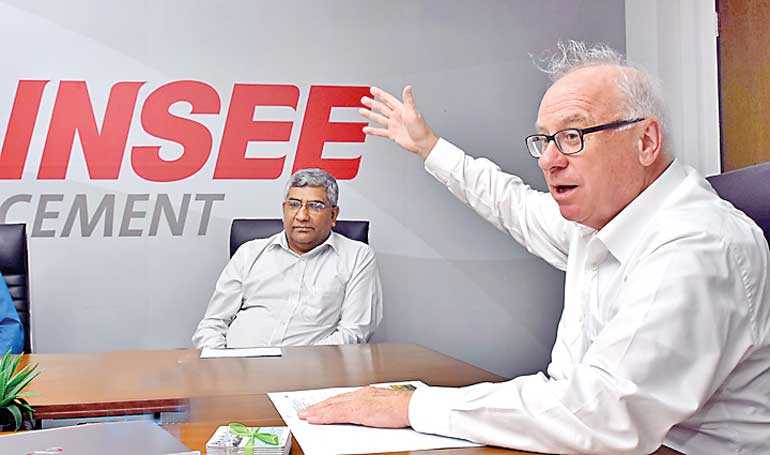Wednesday Dec 24, 2025
Wednesday Dec 24, 2025
Tuesday, 5 June 2018 00:38 - - {{hitsCtrl.values.hits}}
 Siam City Cement Group Chairman, Paul Hugentobler (right) and INSEE Cement
Siam City Cement Group Chairman, Paul Hugentobler (right) and INSEE Cement
Lanka Chief Executive Officer, Nandana Ekanayake at the media briefing – Pic by Indrarathne Balasuriya
Thailand-based Southeast Asian giant Siam City Cement is investing further in Sri Lanka with long term optimism, though it is bit unnerved by medium term concerns.
Having bought Swiss giant Lafarge Holcim’s Sri Lankan operations for $374 million two years ago, Siam Cement continues to remain bullish on future prospects, though the first quarter’s 7% dip in industry sales has perplexed the company.
Nevertheless, Siam City Cement Board Chairman Paul Heinz Hugentobler told journalists in Colombo that the company remains committed to Sri Lanka.
Sri Lanka’s only integrated cement manufacturer now known as INSEE Cement, with the popular “Sanstha” brand, is close to finishing a modern and eco-friendly grinding plant in Galle and will be foraying into ready-mix concrete by next month, two initiatives for which a fresh investment of $20 million has been made.
Siam Cement boasts of having the world’s largest cement plant and is a specialist in ready-mix concrete.
Hugentobler admitted that its Lankan foray into ready-mix concrete is belated, but is confident the company can catch up fast. “Given on-going and planned mega commercial construction, the demand for ‘engineered concrete’ and commercial ready-mix will boom and we are ready to serve it,” Hugentobler said at a briefing to Lankan journalists, appearing along with Sri Lankan CEO Nandana Ekanayake.
Both Hugentobler and Ekanayake pointed out that the company had had had a relatively good year in 2017, but that the first quarter of 2018 had seen a drop of about 7% industry-wide. They noted that this was surprising, even considering the cyclical nature of the cement business, as even during the conflict the cement industry had enjoyed low yet positive growth. They termed this contraction “disconcerting”, also adding that cost pressures on the cement industry were on the rise.
However, INSEE (which means Eagle in Thai) is confident of finishing 2018 on a positive note, aided by a pick-up in user sentiment and favourable policy.
The local industry, which only caters to around 50% of demand, lamented that the retail cement market, made up of household and small builders and accounting for 75% of the market, has been depressed due to adverse weather impacting agriculture, relatively high interest rates and overall economic downturn and higher costs. Nevertheless, INSEE admitted that the bulk cement segment, thanks to mega property and mixed use developments, has grown.